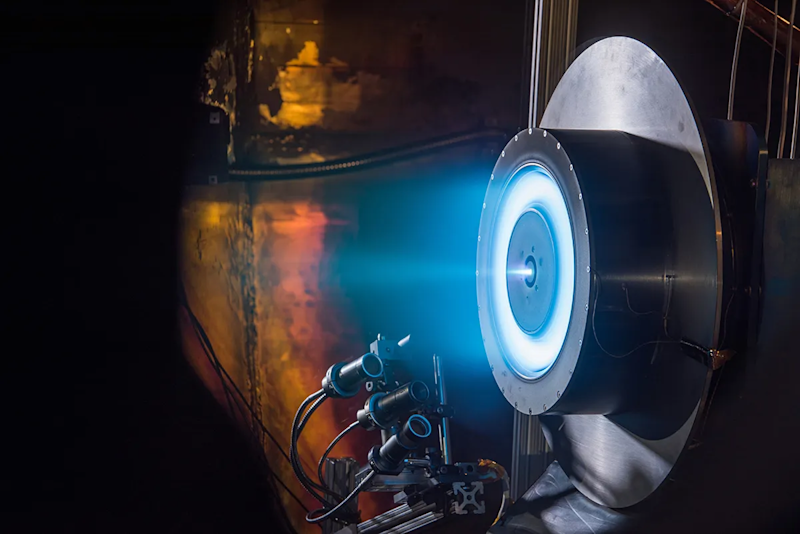Joe Panella’s career has been steeped in manufacturing. Reliability engineer for General Motors’ former Detroit-Hamtramck Assembly plant (now Factory Zero). Project manager for a crankshaft machining line for a Cummins engine factory. Plant manager of a Garrett turbocharger facility. Strategist for the Meritor commercial braking systems business.
You might imagine Panella would be working today in some segment of the auto industry or in some other high-volume manufacturing associated with Detroit.
Nope. He’s now the vice president of manufacturing at Orbion Space Technology in Michigan – but some 550 miles northwest of Detroit, in Houghton, which is located about midway up the peak that sticks out from the top of the Upper Peninsula.
At Orbion, instead of a production rate of 60 jobs per hour, they’re running at about 100 units – per year. (“We’ve got the capacity to go to 1,000 units per year,” he says.)
Oh. And while a car is the size of, well, a car, Panella says that the thrusters Orbion produces are “about the size of a coffee mug.”
Here’s one important thing about Panella’s background that he imparts to his colleagues at Orbion: production quality.
He’s fluent in things like the Toyota Production System (which he says was instrumental in the development of the Cummins Production System, which he helped implement), the 5S methodology, and continuous improvement. All things vital to ensuring the success of a part.
And that is really important because while the NHTSA can initiate a recall for cars and trucks on the road, that’s not feasible for Orbion.
“We can’t have a failure," he says. "Obviously, if you produce something that’s used on Earth and there’s something wrong, you can take it back and repair it. But if it goes into space, it’s a one-way ticket. So we have a lot of processes in place to make sure these systems work.”
And They’re There Because …
As Houghton isn’t particularly close to, say, Cape Canaveral, one might wonder why it is where it is. The company was co-founded in 2016 by Lyon “Brad” King, Ph.D., who was born and raised in Calumet, Michigan – which is even farther north than Houghton. King received his degrees from the University of Michigan and completed a postdoctoral fellowship at the National Research Council at the National Institute of Standards and Technology (NIST) in Boulder, Colorado, before returning to Michigan afterwards.
He likes it there.
One benefit to being located in Houghton is that it’s home to Michigan Technological University and the cadre of smart people at its aerospace-related programs, which is good when your business is actual, not figurative, rocket science. (King is on the faculty there.)
The company has some 70 employees. Michigan Tech is well represented on that staff.
From Outside In
Panella became associated with Orbion when it was in its startup phase and he was consulting for the Michigan Economic Development Corp.’s SmartZone, a private-public partnership for job creation in the state. Panella was assigned to assist Orbion in his position helping companies associated with Michigan Tech develop manufacturing strategies.
Before leaving his assignment at Orbion, he wrote a job description for someone who would help the company ramp up its production.
Six months later, in May 2020, Panella was hired. And they’ve been ramping up the output ever since.
What They Build
The primary product developed and produced at Orbion is the Aurora Hall-effect thruster. That is, the Aurora is a plasma thruster. There is a magnetic field (Orbion uses permanent magnets) that contains the propellent released from the tank. This is typically xenon, though krypton or argon can be used; xenon is more efficient because it has a higher density: 15 kg can be contained in an 8.29-liter tank at 1,300 psia, compared with a 39.37-liter tank for the equivalent amount of krypton and 97.25-liter tank for argon.
The fuel is ionized by electrons from the satellite’s onboard power system (there are two connections between the thruster and the spacecraft: a 28-volt unregulated power connection and an RS-422 data connection), which then accelerates the ions so there are exhaust velocities on the order of 20,000 meters per second.
While that may seem extreme, Panella notes that the thrust is equivalent to the weight of a dime.
“These are not like the diesel engines that I manufactured earlier in my life,” he says, which could be the understatement of the year.
But what, you may wonder, do these thrusters do?
Panella explains they are fitted into commercial and government satellites.
Satellites are being sent up in number on a single rocket, which then drops them off in the same orbit.
“It is like people getting off at a bus stop. Then they have to go to their final location.”
The thrusters allow the satellites to get to that location. Then they are used to keep them there. (Gravity wants to bring them back to Earth.)


One tank of fuel can provide thrust capacity for seven years or more. Fuel tank size has a big effect on the assembled thruster system.
“A customer will give us a keep-in space,” Panella says, explaining that this is the amount of room Orbion has to fit its system within the satellite structure. While other elements are, in effect, “standardized,” the change in fuel tank size can either mean a bigger satellite or a decreased amount of time in space.
And when the satellite’s time in space reaches its end, the thruster can be used for a controlled descent back into the Earth’s atmosphere, rather than one of those random reentries.
There is another option Orbion offers for its Aurora thruster: El Matador, a high-thrust cold-gas nozzle that’s located along the center axis of the thruster head. If another object in space is on track to collide with an Orbion satellite equipped with El Matador, it provides a blast of propellant resulting in up to two Newtons of thrust for evasive maneuvers. Yes, it uses up fuel to achieve that. But when the choice is between a shortened mission and a catastrophically finished one …
Which leads to why things like Orbion thrusters are becoming increasingly important.
At present there are some 9,990 active satellites in orbit.
According to a study recently released by Euroconsult, an average of over 2,800 satellites will be launched annually between 2023 and 2032, which means it is going to get increasingly crowded up there.
What’s more – much, much more – according to the Combined Space Operations Center at the Vandenberg Space Force Base, which runs the Space Surveillance Network, an estimated 8,000 metric tons of space debris is in orbit, and “even a tiny piece could be catastrophic to any of our orbiting assets.”
Which means that thrusters are necessary to maneuver satellites to minimize the possibility of being knocked out by random debris.


Sourcing and Testing
The thruster and the propellant management assembly are produced with parts shipped from suppliers to Orbion. Given that there are some 60 parts in a given thruster head and that there are various materials that need to be machined – from stainless steels to titanium – and because of that aforementioned need for parts to perform as defined once they’re in orbit, the supply base is critical to Orbion.
“We tried to get a Midwest supply base,” Panella says, noting that suppliers working in the medical industry – those familiar with small, precision parts production – are among those who have been contracted by Orbion. Although there are suppliers in Michigan, Illinois, and Minnesota, Orbion is also using manufacturers on the coasts who can provide them with the specific components they need. Shipping is not an issue. “The parts can fit in a small box and be sent via the mail, UPS, or FedEx. Our receiving room measures about 10 feet by 10 feet.”
The power processing unit and the electrical harness assembly are each produced and tested by contract manufacturers.
It is worth noting that components that go into a thruster system are not things that are off the shelf but designed by Orbion engineers.
Because quality is so important, the suppliers do 100% inspection of the parts they produce and provide Orbion with the data on critical characteristics. When the parts arrive at Orbion, they do a random check of a few parts to verify they meet the specs. Should there be any issues, then they work to determine whether this is a measurement or a manufacturing problem in order to resolve it.
One of the things that Panella emphasizes to the people at Orbion is that there is nothing wrong with finding problems. “We want to find problems early and address them.”
Which goes back to the point of the seemingly low output of the plant.
Panella says that they spend about four times the amount of time testing things as they do making them.
They can produce a xenon flow controller in about four hours – and then spend five days testing it.
“Think of the valves. If we have a valve that sticks open when the satellite is in orbit, then the fuel is going to leak out, and the satellite is dead.”
So there is vibration testing, thermal cycle testing, leak testing, and more – both at the component level and the module level.
And because these are systems that are working in space, they have four vacuum chambers where they perform testing not only in a vacuum but also at thermal cycles. After all, there are serious temperature swings in space depending on whether something is in the Sun (e.g., 248 degrees Fahrenheit) or in the shade (minus 148 degrees Fahrenheit).
Not Exactly Hoth From ‘Star Wars’
Which brings us back to Earth, to Houghton.
In 1891 a powerhouse was opened in Houghton on what is known as the Portage Canal. The dynamos and other equipment that filled the building provided electricity for Houghton and Hancock, the small city on the other side of the waterway. The building was built from Jacobsville Sandstone, a reddish stone that is indigenous to the area – as is copper, which helped in the electrification of the country and continues to play a major role in the electrification of vehicles, and which gave rise to the area’s nickname, “Copper Country.”
That building now serves as the headquarters of Orbion. And while perhaps it is merely a coincidence, it does seem fitting that the company produces electrical thrusters.
Outside of Orbion is the Portage Lake Lift Bridge, which provides vertical lift to accommodate boat traffic beneath it. The bridge, opened in 1959, was named a National Historic Civil Engineering Landmark by the American Society of Civil Engineers in 2022. It is the world’s heaviest and widest double-decked vertical-lift bridge in the world.
Clearly when the counterweights, pulleys, and cables are in action, there are some non-trivial vibrations that occur that must be discernable within Orbion's manufacturing operations at their headquarters.
Panella says that while that is the case, there is another building about a mile away where they do the testing, which isn’t affected by the bridge in action.
However, Houghton gets an average annual snowfall of 202 inches.
“During the winter, they remove snow by putting it in dump trucks,” Panella says. It is then moved to designated transfer stations. “They drive by our building. You can feel the floor vibrate as the trucks go by.”
After all, some 17 feet of snow is a lot to handle.
“We’ve been able to filter out the effects when doing the testing,” Panella says.
Despite these small inconveniences, Orbion seems right at home. While most people may have only vaguely heard of Houghton, it is a locale with a lot of engineering prowess – and scenic, to boot.


To read the rest of the Space Issue of MT Magazine, click here.






